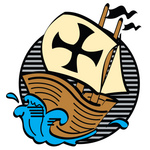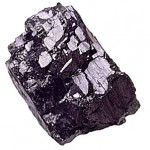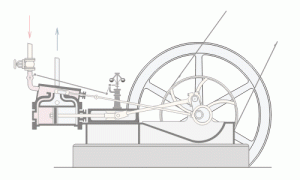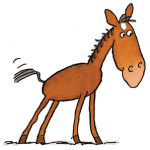Note: As of January 1st 2010 I’m moving to new WordPress software, so all earlier entries are dated as December 28th 2009. They actually range from the summer of 2008 to autumn 2009. If you need to know a specific date for anything, please let me know.
In May I went to Milan to buy Italian books and to have a look around the bookshops to see what new stuff was out. I decided to travel by bus, ferry and train again, as I did last year (see September & October 2008 posts) when I went to Lucca. It’s taken a long time to get my notes and pictures uploaded, partly because we’ve moved house in the interim, but here, at last, they are:
Thursday May 14th
2pm.

Enniskillen bus station is enjoying its usual collection of eccentrics, including a female mallard who has wandered in from the lough and is being fed by an elderly man with pieces of jam doughnut. Meanwhile another man, maybe ten years younger, is expounding to his companion a matter of biological curiosity.
“These English,” he says, in a tone of scientific detachment, tinged with wonder, “I don’t know where they come from but they can all swim.”
The Bus Eireann coach for Dublin pulls in, exotic with its racing setter logo, against the dull blue of the Ulsterbuses. We travel down the rather boring N3, too far west for the sophistication of Belfast; not nearly far enough for the glamour of Galway and Clare. Election posters, huge flapping faces, hang from almost every lamp post, and the small towns have shops with names like Keltic Kuts and greyish G.A.A. grounds. In between, the countryside is pimpled with concrete bungalows which almost, but not quite succeed in masking the soft blue-green beauties of the landscape. On small lakes men potter in fishing boats, indistinguishable from their ancestors except for their outboard motors.
“Five minutes smoke time.” announces the African bus driver as we reach Cavan. A small takeaway near the bus station offers “Probably the best pizza on the planet”. What fun if it were true.
3pm.
After Cavan the clouds shift, and the first glimmers of sunshine filter through, onto spindly colts and cows lying with their spines at right angles like half collapsed tents. I listen to my iPod, soft music to match the greens, surely more than forty shades in the strengthening sun.
6pm.
In Dublin, I think I see more bikes than before, their commuting riders armoured in helmets and fluorescent vests. I take a taxi to the ferry terminal, as the so-called connecting bus is due to arrive ten minutes after check-in is supposed to finish. It would be grand, of course, but if I miss this ferry then the whole journey collapses, domino-style, so I don’t feel confident relying on Irish insouciance.

As usual, the ferry port is a human place to wait, with space, fresh air and a relaxing absence of Tannoy announcements and people trying to sell you things. It’s a real port, with rows of Guiness tankers lined up waiting, a reminder that there is more going on in the world than just holidays, even if it’s only drinking. My new four wheeled suitcase is a delight on its marble floors – less like lugging luggage and more like taking a preternaturally obedient dog for a walk.
As I wait to check in I read John Betjeman on the pleasures of cycling, slow trains and the unexpected joys of wartime simplicity. He writes that Bradshaw, of the famous train timetable, was a Quaker and a ‘great worker for peace’. One of the hoariest canards of literary history is that Bejeman and C. S. Lewis loathed one another, but when Betjeman attended the public enquiry into the proposed nuclear (or ‘atomic’ as it was called then, probably just as logically) power station near Maldon, Essex (Bradwell, now decommissioned but being considered for ‘redevelopment’) it was of Lewis’s That Hideous Strength that he was reminded by the suited managers of the Central Electricity Board.
8pm
On board the Irish Ferries Ulysses, the narrator of the safety announcement begins with a surprisingly English accent, like an old-fashioned BBC presenter, becoming more Irish as he continues, as if Alan Dedicoat were slowly morphing into Terry Wogan.
The Ulysses is the biggest car ferry in the world, but there is only one half deck where passengers are allowed to go outside. After an unintentional detour to the first class and truck drivers’ lounges, I eventually find the Ruby Stairs that lead to freedom. Outside are a few men huddled in the bus shelter designated as the ‘smoking zone’ but no one else to witness our departure from Dublin. Not that there is much to see; dark grey silhouettes in the air force blue twilight and ranks of distant lights.
The rooms on the Ulysses have Joycean names; the Stephen Dedalus suite and the Nora Barnacle Brasserie. On my next trip, to Glastonbury with the boys, we will take the other ferry, the high-speed Swift which turns out to have, painted on its side, the full name of the venerable Dean, but disappointingly no Lilliputian Lounge or Brobdingnagian Bistro. Meanwhile, two tables away, a man is groaning in his sleep – Finnegan’s far from awake.
Friday May 15th
1am.
The waiting area at Holyhead is very cold, and the metal seating rigid and chilled, its perforations painful to every part of the anatomy and its fixed armrests a piece of egregiously bureaucratic callousness.
5am.
A delicious relief to be on the train for London. I sleep better than I can ever remember doing in a seat, though not well enough to avoid hearing the long debate between the ticket collector and a vague Irishman who has lost his ticket and refuses to buy another. He is ejected at Chester and threatened with the Transport Police, a fate at which he is singularly unimpressed.
9.15am

On the Euston Road I join the throng of patient scholars waiting for the British Library to open. It seems a sensible place to spend an hour or two before I have to be at St Pancras, provided that they will let me in with my monstrous suitcase. It turns out that they will, though I spend a good quarter of my time trundling it up and down ramps before I find the right place to leave it. There is just time then to visit a few of the manuscripts on display – drafts of Persuasion, Jane Eyre and Tess of the D’Urbervilles, and to gaze up at the the King’s Library, a magnificent block of patchwork leather and gilt.
Having been reading John Betjeman, I want to pay my respects at his statue, but come into St Pancras from the wrong end, and can’t negotiate the crowds with my suitcase. I make do with remembering what I can of his writing about the station, how it was built as the London terminus of the Midland Railway, after the other companies had already erected their own London edifices, and required a bridge to be built over the canal and the levelling of the old Saint Pancras burial ground. One of the assistant architects was Thomas Hardy and the experience of supervising the exhumation and reburial of the bodies did nothing to lighten his sepulchral gloom. Because of the bridge, the line finished in mid-air, hence the station’s cathedralesque high roof, while the distance between the columns is said to have been measured by the Burton-on-Trent beer barrels which were the Midland’s principal freight.
12 noon.

The Eurostar is crowded but polite, with most of the passengers reading books. Last time I took the train to Italy was just after the fire in the tunnel, so we took the Eurolines coach instead, all noise and jostling and music and rumbling discontent. By contrast, this is sanitized travel, very Home Counties. I slept through the tunnel and woke up thinking that we were still in England with a grey drizzling sky, poplar trees and concrete.
Suddenly we jerk to a grating halt.
“Ladies and gentlemen,” comes the announcement. “We ‘ave stopped.” He promises, in a French accent strongly flavoured with Essex, to find out why, but within a minute we have set off again.
3pm


In Paris I have nearly five hours before my train to Italy, so I decide to walk from the Gare du Nord to Bercy. This goes moderately well, as the suitcase behaves itself on the whole, only occasionally deciding to run over my toes. It looks like less than three miles on the map but takes me over two hours, including the stops to stock up with bread and cheese and the demented wanderings up and down the rue Bercy, having by now completely lost my bearings.

8pm
I am the first to reach our coach, the very last on the Stendhal overnight train to Milan, and despite the lack of numbers for our couchette, manage to locate my bunk. On the top, thank goodness. After travelling in a six-berth couchette last time I’ve belatedly taken the advice of the Man in Seat 61 and gone for the four berth this time. This means that I have only three companions: a young French girl with an astonishing quantity of luggage, a middle-aged Frenchman and a glamorous Russian girl who does her hair up at night with those bendy foam curlers and sprays the couchette with perfume in the morning.
I’d bought a bottle of wine with a screw top as I was walking through Paris but can’t get it open now, so settle for a frugal and sober piece of baguette and chunk of goat’s cheese. I have another, more exciting cheese, a Saint-Marcellin, about which Wikipedia notes that ‘Its degree of runniness increases with age’ This particular piece has evidently passed the limits of senility as it has already oozed out of the packet, filling the couchette with the ripe odour so eloquently described by Jerome K. Jerome .
“A few moments passed, and then the old gentleman began to fidget.
“Very close in here,” he said.
“Quite oppressive,” said the man next him.
And then they both began sniffing, and, at the third sniff, they caught it right on the chest, and rose up without another word and went out. And then a stout lady got up, and said it was disgraceful that a respectable married woman should be harried about in this way, and gathered up a bag and eight parcels and went. The remaining four passengers sat on for a while, until a solemn-looking man in the corner, who, from his dress and general appearance, seemed to belong to the undertaker class, said it put him in mind of dead baby; and the other three passengers tried to get out of the door at the same time, and hurt themselves.”
(Three Men in a Boat, Chapter Four)
Fortunately I have with me an almost inexhaustible supply of small plastic bags and manage to imprison the Saint-Marcellin in almost decent obscurity before the others arrive.
11pm
I’m feeling a bit miserable now. Last time I did this journey it was with my son, who seems very far away now in Australia and though I’m very tired from the previous night on the Holyhead benches, I can’t sleep properly until the Frenchman finally switches off the central light. Maybe I should get one of those eye masks.
Saturday May 16th
4.30am

I wake from what feels like a proper sleep at last, and am filled immediately with the elation of being in Italy, as unmistakable as the mild depression induced in France. At Milan’s Stazione Centrale the loos aren’t open yet so I sit on a marble bench near a couple of suspicious lurking young men. As soon as they speak, I realize that they are simply American students straight out of a frat-boy comedy; no doubt the most dangerous of all from a global point of view but reassuring from my selfish perspective. I sort out my suitcase – Saint Marcellin is still with me, faintly stinking through his polythene. I can’t work out quite which of the carefully colour co-ordinated recycling bins ought to be his next home.
A Parisian woman and her little girl, about four years old, join me for a while and we have fun naming objects in English and French. They were on the same train and are here to spend a few days with the woman’s boyfriend who works in Milan.

At around six o’clock he arrives and I set off for my hotel to drop off the suitcase. I follow the hotel website’s instructions to take the tram, which means a long trudge around looking for the right stop but then only a short wait before the tram arrives. On this line the trams are old traditional ones with lovely wooden benches along the sides. An announcement tells us which stop we will reach next, but the creaks and squeaks of the ancient wood and iron make it almost impossible to hear. Somehow, despite, this, I manage to clamber down – the tram floor is a good few feet higher than the road, at more or less the right place.
7.30am

At the hotel, the Ariston, celebrated for its organic and recycled stuff, I’m overjoyed to hear that my room is ready – I’d expected only to be able to leave my case and to have to wander unwashed around Milan until three o’clock. But as it is, I can have a shower before setting out to the Saturday street markets.
10am
The first of these is easy to find but no good for me, having only clothes and a few food stalls: fruit and vegetables, fish and cheese. Heading for the second, I disastrously confuse the Strada Alzaia Naviglio Grande with the Strada Alzaia Naviglio Pavese and walk several miles before I realise that I am skirting entirely the wrong canal and have walked several miles in the wrong direction. It wasn’t even an interesting detour, consisting mainly of garages and apartment blocks, but the way back was at least straightforward, and the market, when I eventually found it, had plenty of useful book stalls. Waiting for the tram to take me back to the hotel, my rucksack straps digging into my shoulders, I fleetingly wonder whether I should have taken up their free bike hire offer, but the combination of my lack of sleep, the tramlines criss-crossing the road and the unbalanced loads of books make me glad I haven’t risked it. Next time, maybe. I drop the books back at the hotel and wander into the city centre – on foot again – mooching around the bookshops, piazzas and park.

On the tram stops are paper notices advertising the fact that the routes will be changed tomorrow morning to accommodate the Giro (the big Italian cycle race, the equivalent of the Tour de France), the next stage of which will be held in the city centre. I hardly dare to believe it, and phone home to check. Martin managed to see it during both years that we lived in Italy and I joked before I left that perhaps it would come near Milan this weekend. It seemed too forlorn a hope even to make it worth looking at the route before I set out. But now, whatever else I need to do tomorrow, I resolve to try to catch a glimpse of it.
7pm
The hotel doesn’t have a restaurant but the barman has stuff he can heat up, so I stay there and eat a risotto – my first proper meal since Thursday lunchtime, before collapsing on my bed in front of the Italian news and a dubbed version of Beethoven (the film with the St Bernard dog, not a biopic of the composer). After Beethoven comes another, even more sentimental dubbed family film with two orphaned sisters, a collection of resolutely pre-Vatican Two nuns, a pair of evil burglars (who intriguingly used MacBooks to plan their dastardly crimes) a rich and wholesome young couple, a plump Latino housekeeper and an anal-retentive mayor who, by the closing credits, sees the error of his ways. Oh, and holding the whole thing together, an extremely large and endearing dog. I’m sure you can deduce the plot from the above elements (and probably also name the film and to what extent it was sponsored by Microsoft). Films like this are most comforting in allowing me to imagine that my Italian listening skills are passable – the fact that an intellectually challenged oyster could work out what was going on if the film was dubbed in Klingon doesn’t really register.
I have a vague idea that a very early night would be advisable, but ought to know better…
11pm
Some sort of male celebration has been going on outside for the past half hour: cars being driven around with full-throated horns and roaring cheers. It occurs to me that if I heard such a din in Northern Ireland I would be at least annoyed and probably rather frightened. I don’t know whether the actual sounds here are unthreatening or whether it’s just that I know it’ll be a question of football. I don’t know which victory, though; didn’t notice anything particular on the news. I hope it’s not Manchester United who, even the Italian news report, secured the Premier League title today by drawing with Arsenal. Surely the evil tentacles of globalization haven’t quite reached so far. Unless it’s an eve-of-Giro-tappa-celebration, which would make it even more Italian and even less irritating; hard to imagine British youths welcoming a bike race with such gusto, Sir Chris Hoy or no.
Another fifteen minutes and the din is redoubled. A good thing that I wasn’t really attached to the early night plan.
Sunday May 17th



The Giro is due to start at eleven, so I am ready and waiting at the Piazzo Duomo by twenty past ten. I really ought to know better. At around one o’clock, after urgent conversations by telefonini and radios, and lots of typically Italian civic stuff with school children and local dignitaries, the first special guests begin to arrive for the opening ceremony. By now I am bright red from the sun and have changed places in the piazza countless times in the hope of finding a good viewpoint.

But today the gods, or maybe Saint Ambrose, are looking after me for I find myself in a blessed corner with a good view of the stage. What’s more, I am just one row back from the arriving corridori (riders, not corridors) and V.I.P.s (pronounced Veeps in Italy). To my joy, the first Veep is our old Lucchese neighbour Mario Cipolini who used to go on practice rides past our house and one glanced quizzically, but not without approval, at my little red Moulton. After Mario come more superstars of Italian cycling; Paolo Bettini and Danilo di Luca, and finally, following a drawn out and teasing build-up, and description as a ‘space cowboy’ which I’m not sure he appreciates, Lance Armstrong.

2pm

After the opening ceremony I meander with the crowd to the Castello Sforzesco. The race consists of eleven circuits of the city centre and the green area surrounding the Castello looks like one of the best vantage points. I can sit in comfort on the grass, getting up when warned by the first police motorbike to stand at the side of the road to watch the peleton go by. I watch three of the circuits consecutively, though I’m confused by the timing; according to my calculations they should reappear every ten minutes, but it turns out to be more like fifteen or twenty. Later my arithmetic is to be vindicated but for now I just assume that I’ve got in a mental muddle.



3pm
Before the fourth I decide to pause my transformation into a lobster – two Senegalese traders have already remarked on my colour, one suggesting that I will soon look like him – so I go into the shady Castello and pay my three euro entry fee for the complex. This includes six museums, but I miss out the prehistoric and Egyptian ones and most of the furniture, being totally overwhelmed by the sculpture and paintings including Michelango’s unfinished Rondanini Pieta (more mysterious and moving than the smooth perfection of the Vatican version) and pictures by Filippo Lippi and Canaletto. I’ve never been to the big Italian art galleries – not even the Uffizi – but this one is completely breathtaking, even more so as it is so quiet and empty. I wonder whether they’d get more visitors if they charged twenty euro but meanwhile am profoundly grateful and determined to come back again with more time. There is also a museum of musical instruments with weird nineteenth century guitars that I might use to tempt the boys into a future trip.
7pm

Afterwards I go to mass at the Cathedral, visit a few more bookshops, listen to a brass band and stop for a pizza. At the table behind me an Australian is explaining to a couple of Americans that he stayed in Italy for a couple of extra days after his business trip in order to see the Giro. When the Americans leave, I ask him whether he saw the finish. It turns out that the riders had safety concerns about the route (he didn’t know exactly what, but I wonder whether it might be at least partly those ubiquitous tram lines, which are a perfect size to trap a wheel) and so they made a collective decision to ride deliberately slowly for most of the race. At the last circuit the sprinters were let off the leash and Mark Cavendish won, with an Ozzie (sorry, I’ve forgotten who) in second.

Meanwhile an impromptu demonstration in the piazza sort of solves the mystery of last night’s hilarity – a football team (Inter, I think) have won something significant (come top of Seria A?). No doubt someone can put me right.
9pm
Laden with books, I collect my suitcases from the hotel and clamber up into the number 2 tram with the help of a quick-witted passenger. At the Stazione Centrale I take the lift into the waiting room, which, with its wooden pew-like benches and collection of the weary and derelict, makes me think of nothing so much as a Victorian workhouse.
11pm
The train, another sleeper back to Paris, is on the platform before eleven – a pleasant surprise, as I had expected it to come from Venice. I am the youngest person in the couchette this time, which feels odd; I had expected to be the oldest. There would have been a much younger occupant – one of around four months – but his grand-mere has accidentally booked the top book for him and his mother so a middle-aged Italian woman from another compartment swaps places with them. The other two are both French – a man in his late sixties and a large woman who decides to keep her suitcase on her bunk and consequently spreads herself across the floor. At some stage during the night she unhooks the ladder to the top bunks in order to better accommodate her legs, leaving the Italian woman and I, in an emergency, with the only expedient of launching ourselves into her lap. Fortunately, no such eventuality occurs.
Monday May 18th
9am

The walk and metro journey from Paris Bercy to the Gare du Nord involves a lot of steps but fortunately also a lot of gallant Frenchmen to help with the larger of the suitcases. I suspect that a few regret the chivalrous impulse – they probably assume it to be full of clothes, rather than books, but none are so craven as to abandon it mid-flight. It later occurs to me that I am wearing a flowered smock top of what could be construed as maternity cut, which may account for some of the gallantry. At the Gare du Nord soldiers are strolling around in camouflage gear – camouflage for a jungle, that is, or a dense forest, and rather more conspicuous amidst the grey suits and fawn raincoats of the French in Monday morning motion. I notice that it is only the youngest and most timid looking of the soldiers who are armed, but don’t know whether to be reassured or alarmed by this.
11am

Nothing much to say about Eurostar – again it’s incredibly bland compared with other train journeys or other ways to cross the Channel (apart from flying, of course, which is the essence of homogeneity). The passengers, whether English or not, all appear to come from Maidenhead and are polite, reserved and uncommunicative. There is no tension, not even a whisper of the exciting confusions and unbearable frustrations of the Eurolines coach.
1pm

fFrom St Pancras I walk to Euston, which is trickier than expected, ploughing into a headwind so strong that it blows down a seven foot weighted pavement sign advertising the Betjemanesque café, which in turn narrowly misses a couple of young Asian tourists. I leave my cases at left luggage and head for the British Museum, partly because the loos are clean and free, partly to provide a bit of symmetry to my outward visit to the British Library and partly to have a mooch around another room or two. A couple of years ago I used to go to London quite regularly for the boys’ trips to the Magic Circle and got into the habit of calling into the B.M. for an hour or so at a time. It’s much less tiring that way, and gives the chance to see a few things properly rather than to leave bombarded with mummies, amphorae and a sense of archaeological indigestion. Now I visit a nice little exhibition of eighteenth century miniatures, drawings and watercolour portraits – pleasant and interesting enough but a little insipid after the wonders of the Castello Sforzesco. There is a late Michelangelo cartoon, though, which I am sitting in front of almost exactly twenty-four hours after standing before the unfinished Pieta. The most moving thing in the museum today for me isn’t an artifact at all, but a simple wall display in a single frame about the effect of the Iraq war on the country’s historical sites and treasures. It doesn’t say much, which makes its criticism the more bitter, quietly illustrated by before and after photographs and a picture of the Allied military base hammered into the site of Babylon itself.
7pm
The sky is a bright blue as we pull out of Euston but by Milton Keynes it is a grey fuzz. A little further northwest pinkish gaps appear and as we pass the first canals and redbrick farmhouses of the Midlands, the soft green curves are lit with a slanting golden light. I wrote about the Shire last time, so I won’t repeat myself, but there are real narrowboats and canalside pubs, and healthy looking Friesans and barns with geometric brick decoration, and a kind of settled, humble peace that you don’t find at either end of the journey, either in Ireland or Italy. I slept through this part of the journey on the way out and now, vaguely aware of how close we will come to my family and home town, I feel rather like Mole in Wind in the Willows when he unexpectedly comes across the entrance to his burrow. But I still don’t realise until we’re almost there, that we are going right through Stafford itself, past the playing fields of my primary school and a few yards from my parents’ house. I jump up to look out of the opposite window in case they are taking an evening stroll through the Doxey Marshes (though I don’t even know whether the marshes are strollable without waders). Before I sit down again I’m ready to explain my eccentric behaviour, but this is England and everyone is studiously pretending that they haven’t noticed.
10pm
It is dark for the last part of the journey, around the Welsh coastline, though the red-painted benches on Colwyn Bay station are jolly. One other passenger in the Quiet Coach has travelled all the way to Holyhead from London, a gentle wispy old Irishman who moved his bags at Euston to make way for my big cases. He offers to help me move them from the train platform to the ferry terminal but all I need is a guide to follow in the near-blackness. It is almost eleven, and we have nearly four hours to wait for the ferry, but this is the last direct train from London, and I didn’t want to have to cart the cases from train to train at Chester and maybe end up stranded there. “I’ve missed this ferry many a time,” says the old man in a wistful tone.
Before sitting down, I take out as much of my laundry as is decent and pad the metal chair with it. It doesn’t exactly feel luxurious but I remind myself of what the cold punched surface would be like otherwise. A small girl comes to tell me that she is staying up all night, but is called away sharply by her mother.
My notes stop here, and I’m not sure, writing this up three months later, whether there was nothing else to say or whether I was just too tired to say it. I remember an extraordinarily comfortable red leather sofa on the ferry, upon which I slept instantly and deeply, the bus from the ferry port into Dublin, during which my suitcase made frequent bids for liberty via the ankles of a polite African and the bliss of settling down on the back seat of the first morning bus from Dublin to Enniskillen. The suitcase had its revenge on the walk home from Enniskillen bus station, mangling one of its wheels, but has now been replaced by a ready and willing clone. Apart from that little blip, the journey was an astonishing success, with no significant delays or frustrations, lots of opportunities for fascinating people-watching, a few interesting conversations, a bit of art, a lot of books and the unexpected excitement of a world-class cycling race. And a glimpse of Mario and the Space Cowboy. You don’t get all that on Ryanair.
 Just as the whales were getting really nervous, certain enterprising Unmerry Ones began digging in the ground for a new liquid* which they called “Oy y’all!” after the cry they uttered upon finding it. Oy y’all had, like Cole, taken hundreds of millions of years to form, and had once been tiny creatures and algae that had fallen to the prehistoric ocean floor and been buried under mud and sediment. Like Cole, it contained enormous reserves of energy, and like Cole, it was sold and burned as quickly as it could be pumped out of the ground. With the help of government tax breaks (not to be the last) Oy y’all, suitably refined, soon became the fuel of choice for Mutton lamps and lubrication.
Just as the whales were getting really nervous, certain enterprising Unmerry Ones began digging in the ground for a new liquid* which they called “Oy y’all!” after the cry they uttered upon finding it. Oy y’all had, like Cole, taken hundreds of millions of years to form, and had once been tiny creatures and algae that had fallen to the prehistoric ocean floor and been buried under mud and sediment. Like Cole, it contained enormous reserves of energy, and like Cole, it was sold and burned as quickly as it could be pumped out of the ground. With the help of government tax breaks (not to be the last) Oy y’all, suitably refined, soon became the fuel of choice for Mutton lamps and lubrication. There was one annoying by-product of the refining process, an extremely nasty form of Oy y’all which the Unmerry Ones called Gaz O’Lean and the Angry-Sackmen called Pet Roll. This stuff was too revolting for any use except to kill lice on Mutton children’s heads (what became of the children is not recorded) and most of it ended up being dumped in streams and rivers. This was irritating to the Oy y’all barons, not because they cared particularly what happened to streams and rivers (most of them would soon have their own swimming pools) but because the Gaz O’Lean wasn’t making them any money. Something would have to be done about that.
There was one annoying by-product of the refining process, an extremely nasty form of Oy y’all which the Unmerry Ones called Gaz O’Lean and the Angry-Sackmen called Pet Roll. This stuff was too revolting for any use except to kill lice on Mutton children’s heads (what became of the children is not recorded) and most of it ended up being dumped in streams and rivers. This was irritating to the Oy y’all barons, not because they cared particularly what happened to streams and rivers (most of them would soon have their own swimming pools) but because the Gaz O’Lean wasn’t making them any money. Something would have to be done about that.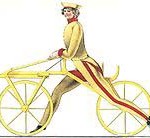 Meanwhile, back in the Old World, a quiet revolution was taking place. Two revolutions, to be exact, one a foot or so behind the other. For a long time far-sighted members of the flock had been toying with the idea of a Mutton-powered wheeled method of personal transport. They had begun by simply making a model of one of their four-legged friends, adding wheels where its hooves would have been, and scooting the contraption along with their feet. This had the dual effect of wearing out their shoes far more quickly than ordinary walking would have done, and of creating great hilarity among the Mutton onlookers.
Meanwhile, back in the Old World, a quiet revolution was taking place. Two revolutions, to be exact, one a foot or so behind the other. For a long time far-sighted members of the flock had been toying with the idea of a Mutton-powered wheeled method of personal transport. They had begun by simply making a model of one of their four-legged friends, adding wheels where its hooves would have been, and scooting the contraption along with their feet. This had the dual effect of wearing out their shoes far more quickly than ordinary walking would have done, and of creating great hilarity among the Mutton onlookers. But the visionaries were not down-hearted (a little bruised from time to time, but not downhearted) and over time they gradually got rid of the more anthropomorphic aspects of the contraption, replacing the animal’s body with a simple triangular framework, discarding two of the four wheels and adding pedals, brakes and air-filled tyres. The machine was no longer a hobby-horse, pedestrian curricle or velocipede; it was a Byk, and everybody wanted one. Even the Angry-Sackmen’s queen, a less bellicose monarch than old Bus, ordered a specimen of the three-wheeled variant to pedal herself around the palace gardens.
But the visionaries were not down-hearted (a little bruised from time to time, but not downhearted) and over time they gradually got rid of the more anthropomorphic aspects of the contraption, replacing the animal’s body with a simple triangular framework, discarding two of the four wheels and adding pedals, brakes and air-filled tyres. The machine was no longer a hobby-horse, pedestrian curricle or velocipede; it was a Byk, and everybody wanted one. Even the Angry-Sackmen’s queen, a less bellicose monarch than old Bus, ordered a specimen of the three-wheeled variant to pedal herself around the palace gardens. It wasn’t queens, though, or even the writers, artists and philosophers who took up Byking with such eccentric enthusiasm, who benefited most from the new invention. For the first time, ordinary Muttons, who could never have afforded to buy or look after a saddled animal of their own, could travel significantly further and faster than their feet could carry them. The Byk was, and still is, the most efficient form of Mutton transport ever, was cheap to buy and didn’t need stabling, feeding or rubbing down when it got too hot. The combination of the Byk and cheap train travel meant that city-dwelling Muttons no longer had to live in huddled hovels close to their workplaces; they could move out a few miles to healthier, more spacious houses where their children could breathe clean air and drink clean water. In the countryside, Muttons could Byk beyond their own villages in search of love, ending centuries of enfeebling inbreeding.
It wasn’t queens, though, or even the writers, artists and philosophers who took up Byking with such eccentric enthusiasm, who benefited most from the new invention. For the first time, ordinary Muttons, who could never have afforded to buy or look after a saddled animal of their own, could travel significantly further and faster than their feet could carry them. The Byk was, and still is, the most efficient form of Mutton transport ever, was cheap to buy and didn’t need stabling, feeding or rubbing down when it got too hot. The combination of the Byk and cheap train travel meant that city-dwelling Muttons no longer had to live in huddled hovels close to their workplaces; they could move out a few miles to healthier, more spacious houses where their children could breathe clean air and drink clean water. In the countryside, Muttons could Byk beyond their own villages in search of love, ending centuries of enfeebling inbreeding. For female Muttons the Byk was especially liberating; suddenly they were throwing away the ridiculous tent-like contraptions they had been clothed in and exploring the world beyond the chaperonage of their fathers and husbands.
For female Muttons the Byk was especially liberating; suddenly they were throwing away the ridiculous tent-like contraptions they had been clothed in and exploring the world beyond the chaperonage of their fathers and husbands.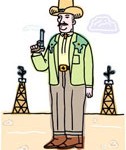 There was money to be made in Byks themselves, of course, but it wasn’t the kind of easy pickings that the rich Muttons liked, not like the money gushing out of the ground in the form of Oy’all. Indeed, the name of one Oy’all-dealing Mutton, known as Flockaseller for his habit of bankrupting his neighbours, had already become synonymous with obscene and frankly ridiculous levels of wealth. There had to be something that Flockaseller and his cronies could do to get ordinary Muttons off their Byks and back to the important business of spending money they couldn’t afford on stuff they didn’t need. And if that something could involve getting rid of the unpleasant, unwanted Gaz O’Lean, so much the better.
There was money to be made in Byks themselves, of course, but it wasn’t the kind of easy pickings that the rich Muttons liked, not like the money gushing out of the ground in the form of Oy’all. Indeed, the name of one Oy’all-dealing Mutton, known as Flockaseller for his habit of bankrupting his neighbours, had already become synonymous with obscene and frankly ridiculous levels of wealth. There had to be something that Flockaseller and his cronies could do to get ordinary Muttons off their Byks and back to the important business of spending money they couldn’t afford on stuff they didn’t need. And if that something could involve getting rid of the unpleasant, unwanted Gaz O’Lean, so much the better.